The Feline Innovators of Historical Narratives: Cats and Their Unseen Pawprints on History’s Canvas
- 3 Comments
Throughout the annals of history, certain figures have indelibly marked the course of human development, their actions shaping the world as we know it. Yet, amidst the grand tapestry of historical narratives, one often-overlooked contributor has silently padded through the corridors of time: the humble cat. With quiet grace and singular mystique, cats have left their pawprints on numerous chapters of history, influencing events and individuals in ways both subtle and profound.
In ancient Egypt, cats were revered to the point of deification. The goddess Bastet, often depicted as a lioness or domestic cat, was a symbol of protection, fertility, and motherhood. Such reverence extended beyond religious iconography; the Egyptians’ veneration of cats led to laws forbidding their exportation, and to the severe punishment of those who harmed them. This protection allowed cats to flourish, ensuring their role as vital pest control agents in granaries, which in turn supported Egypt’s economy and food security.
Further afield, in the winding streets of medieval Europe, cats played a pivotal role during the Black Death. As the bubonic plague swept across the continent, decimating populations, cats were instrumental in controlling the rat populations that were vectors of the disease. While initially subject to suspicion and persecution due to superstitions, their undeniable utility in combating the pestilence eventually led to a resurgence in their population and status.
In Japan, cats have been part of the cultural narrative since they were introduced from China in the 6th century. These feline companions were not only cherished as protectors of valued Buddhist scriptures from rodents but also celebrated in art and folklore. The iconic “Maneki-neko,” or “beckoning cat,” is a talisman believed to bring good luck and fortune, underscoring the cultural integration and significance of cats in Japanese society.
The tales of cats navigating the complex social and political landscapes extend to the courts of Europe as well. Cardinal Richelieu, the powerful French statesman, was known for his deep affection for cats, keeping several in his chambers at all times. These feline companions were said to have provided Richelieu with comfort and inspiration during his tenure as chief minister under King Louis XIII. His fondness for cats even led to the establishment of provisions in his will for the care of his beloved pets after his death.
As history advanced into the modern era, the presence of cats continued to weave into the fabric of human stories. In the trenches of World War I, cats served alongside soldiers, controlling the rodent populations that thrived in the harsh conditions. Their presence offered not only practical benefits but also psychological comfort to the troops. Similarly, during World War II, cats were enlisted aboard naval vessels to protect supplies from vermin, becoming unofficial mascots and cherished companions to sailors.
In literature and media, cats have frequently served as muses for writers and artists. From T.S. Eliot’s whimsical “Old Possum’s Book of Practical Cats” to the mysterious allure of Edgar Allan Poe’s feline figures, cats have inspired countless creators, their enigmatic nature mirroring the complexities of human emotion and imagination.
Today, as we continue to explore the myriad ways in which cats influence our world, their historical impact remains a testament to their enduring presence. From ancient deities to modern-day icons, cats have silently shaped our past, their contributions woven into the stories of human civilization. As we look to the future, the legacy of cats as quiet innovators and companions continues to unfold, inviting us to appreciate their subtle yet profound influence on the course of history.

Throughout the annals of history, certain figures have indelibly marked the course of human development, their actions shaping the world as we know it. Yet, amidst the grand tapestry of historical narratives, one often-overlooked contributor has silently padded through the corridors of time: the humble cat. With quiet grace and singular mystique, cats have left their pawprints on numerous chapters of history, influencing events and individuals in ways both subtle and profound.
In ancient Egypt, cats were revered to the point of deification. The goddess Bastet, often depicted as a lioness or domestic cat, was a symbol of protection, fertility, and motherhood. Such reverence extended beyond religious iconography; the Egyptians’ veneration of cats led to laws forbidding their exportation, and to the severe punishment of those who harmed them. This protection allowed cats to flourish, ensuring their role as vital pest control agents in granaries, which in turn supported Egypt’s economy and food security.
Further afield, in the winding streets of medieval Europe, cats played a pivotal role during the Black Death. As the bubonic plague swept across the continent, decimating populations, cats were instrumental in controlling the rat populations that were vectors of the disease. While initially subject to suspicion and persecution due to superstitions, their undeniable utility in combating the pestilence eventually led to a resurgence in their population and status.
In Japan, cats have been part of the cultural narrative since they were introduced from China in the 6th century. These feline companions were not only cherished as protectors of valued Buddhist scriptures from rodents but also celebrated in art and folklore. The iconic “Maneki-neko,” or “beckoning cat,” is a talisman believed to bring good luck and fortune, underscoring the cultural integration and significance of cats in Japanese society.
The tales of cats navigating the complex social and political landscapes extend to the courts of Europe as well. Cardinal Richelieu, the powerful French statesman, was known for his deep affection for cats, keeping several in his chambers at all times. These feline companions were said to have provided Richelieu with comfort and inspiration during his tenure as chief minister under King Louis XIII. His fondness for cats even led to the establishment of provisions in his will for the care of his beloved pets after his death.
As history advanced into the modern era, the presence of cats continued to weave into the fabric of human stories. In the trenches of World War I, cats served alongside soldiers, controlling the rodent populations that thrived in the harsh conditions. Their presence offered not only practical benefits but also psychological comfort to the troops. Similarly, during World War II, cats were enlisted aboard naval vessels to protect supplies from vermin, becoming unofficial mascots and cherished companions to sailors.
In literature and media, cats have frequently served as muses for writers and artists. From T.S. Eliot’s whimsical “Old Possum’s Book of Practical Cats” to the mysterious allure of Edgar Allan Poe’s feline figures, cats have inspired countless creators, their enigmatic nature mirroring the complexities of human emotion and imagination.
Today, as we continue to explore the myriad ways in which cats influence our world, their historical impact remains a testament to their enduring presence. From ancient deities to modern-day icons, cats have silently shaped our past, their contributions woven into the stories of human civilization. As we look to the future, the legacy of cats as quiet innovators and companions continues to unfold, inviting us to appreciate their subtle yet profound influence on the course of history.









3 thoughts on “The Feline Innovators of Historical Narratives: Cats and Their Unseen Pawprints on History’s Canvas”
This post beautifully highlights the significant role cats have played throughout history.
It’s wonderful to see the appreciation for the historical significance of cats. Their impact across various cultures and eras is truly fascinating.
It’s great to see the recognition of cats’ historical significance. Their influence across different cultures and periods is indeed captivating.